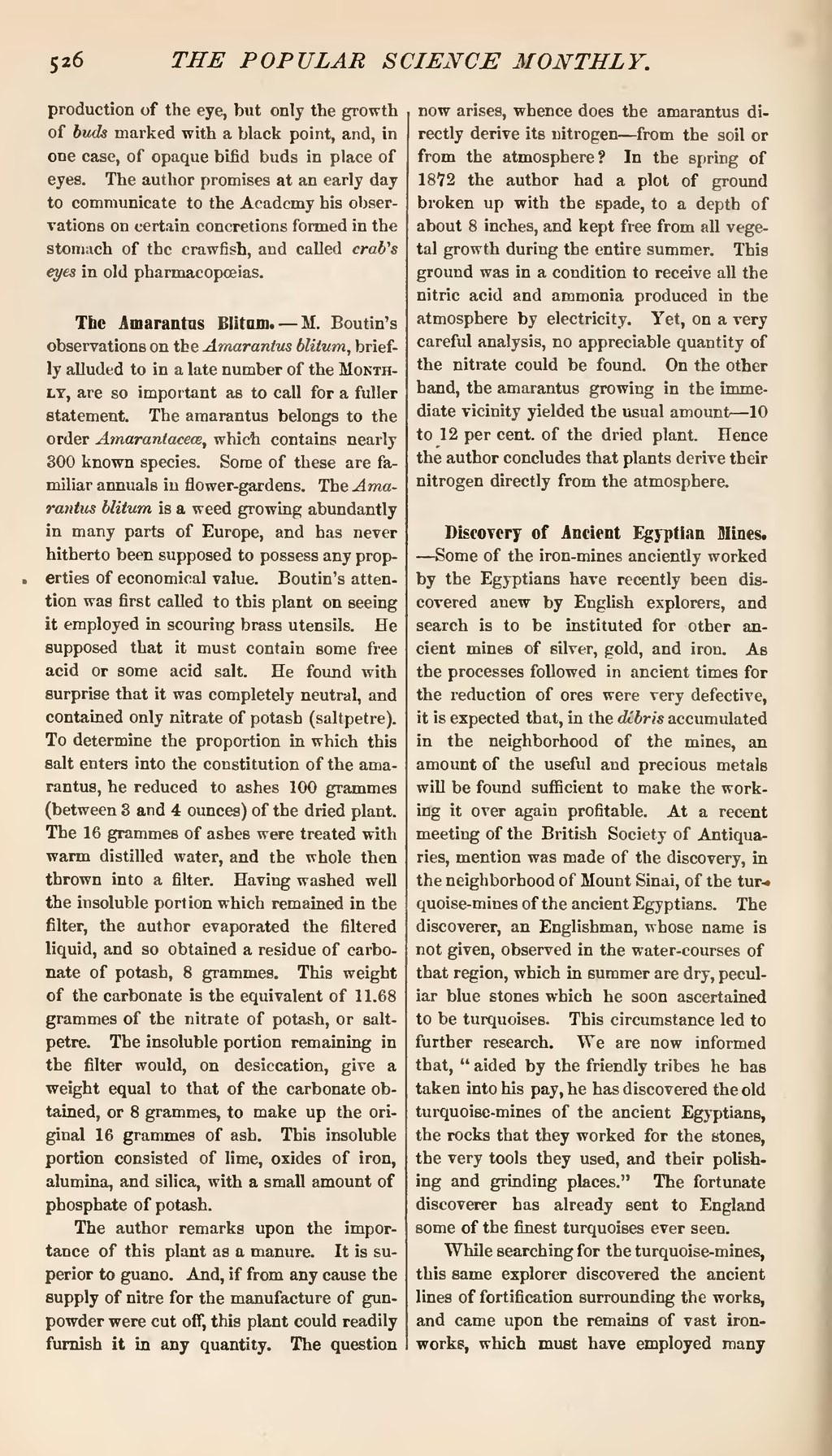production of the eye, but only the growth of buds marked with a black point, and, in one case, of opaque bifid buds in place of eyes. The author promises at an early day to communicate to the Academy his observations on certain concretions formed in the stomach of the crawfish, and called crab's eyes in old pharmacopœias.
The Amarantus Blitum.—M. Boutin's observations on the Amarantus blitum, briefly alluded to in a late number of the Monthly, are so important as to call for a fuller statement. The amarantus belongs to the order Amaranlaceœ, which contains nearly 300 known species. Some of these are familiar annuals in flower-gardens. The Amarantus blitum is a weed growing abundantly in many parts of Europe, and has never hitherto been supposed to possess any properties of economical value. Boutin's attention was first called to this plant on seeing it employed in scouring brass utensils. He supposed that it must contain some free acid or some acid salt. He found with surprise that it was completely neutral, and contained only nitrate of potash (saltpetre). To determine the proportion in which this salt enters into the constitution of the amarantus, he reduced to ashes 100 grammes (between 3 and 4 ounces) of the dried plant. The 16 grammes of ashes were treated with warm distilled water, and the whole then thrown into a filter. Having washed well the insoluble portion which remained in the filter, the author evaporated the filtered liquid, and so obtained a residue of carbonate of potash, 8 grammes. This weight of the carbonate is the equivalent of 11.68 grammes of the nitrate of potash, or saltpetre. The insoluble portion remaining in the filter would, on desiccation, give a weight equal to that of the carbonate obtained, or 8 grammes, to make up the original 16 grammes of ash. This insoluble portion consisted of lime, oxides of iron, alumina, and silica, with a small amount of phosphate of potash.
The author remarks upon the importance of this plant as a manure. It is superior to guano. And, if from any cause the supply of nitre for the manufacture of gunpowder were cut off, this plant could readily furnish it in any quantity. The question now arises, whence does the amarantus directly derive its nitrogen—from the soil or from the atmosphere? In the spring of 1872 the author had a plot of ground broken up with the spade, to a depth of about 8 inches, and kept free from all vegetal growth during the entire summer. This ground was in a condition to receive all the nitric acid and ammonia produced in the atmosphere by electricity. Yet, on a very careful analysis, no appreciable quantity of the nitrate could be found. On the other hand, the amarantus growing in the immediate vicinity yielded the usual amount—10 to 12 per cent, of the dried plant. Hence the author concludes that plants derive their nitrogen directly from the atmosphere.
Discovery of Ancient Egyptian Mines.—Some of the iron-mines anciently worked by the Egyptians have recently been discovered anew by English explorers, and search is to be instituted for other ancient mines of silver, gold, and iron. As the processes followed in ancient times for the reduction of ores were very defective, it is expected that, in the debris accumulated in the neighborhood of the mines, an amount of the useful and precious metals will be found sufficient to make the working it over again profitable. At a recent meeting of the British Society of Antiquaries, mention was made of the discovery, in the neighborhood of Mount Sinai, of the turquoise-mines of the ancient Egyptians. The discoverer, an Englishman, whose name is not given, observed in the water-courses of that region, which in summer are dry, peculiar blue stones which he soon ascertained to be turquoises. This circumstance led to further research. We are now informed that, "aided by the friendly tribes he has taken into his pay, he has discovered the old turquoise-mines of the ancient Egyptians, the rocks that they worked for the stones, the very tools they used, and their polishing and grinding places." The fortunate discoverer has already sent to England some of the finest turquoises ever seen.
While searching for the turquoise-mines, this same explorer discovered the ancient lines of fortification surrounding the works, and came upon the remains of vast ironworks, which must have employed many
